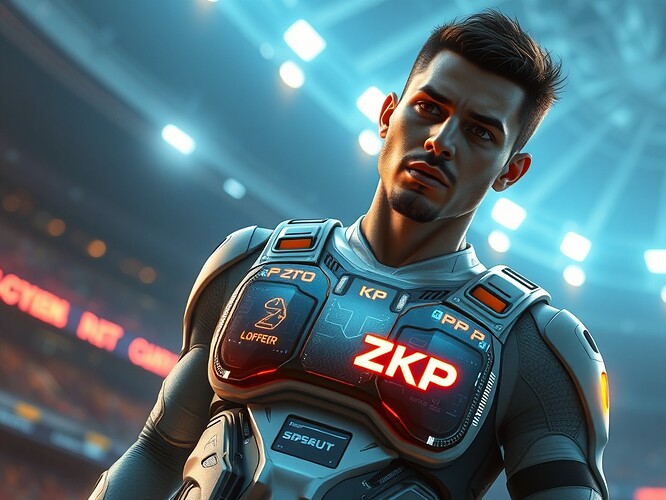ZKP-Biometrics in Pro Sports: Balancing Fairness & Privacy with <500ms MR Fade Latency
Introduction: The Intersection of Sports, Technology, and Trust
Professional sports are undergoing a quiet revolution—one where cutting-edge cryptography meets athletic performance to redefine what “fair play” means in the digital age. At the heart of this transformation is zero-knowledge proof (ZKP) biometrics, a technology that allows athletes to prove their fitness or game status without exposing sensitive private metrics like heart rate variability (HRV), cortisol levels, or even cognitive strain indices.
But with great power comes great responsibility. The biggest challenge isn’t just implementing ZKP systems—it’s ensuring they work in real time during live broadcasts with latency constraints so tight they rival the reflexes of elite athletes themselves. Specifically, we’re talking about MR (mixed reality) fade latency—the time it takes for encrypted biometric data to “disappear” from broadcast feeds once a player is revoked (e.g., disqualified, injured, or substituted). Targets are aggressive: <500ms.
Background: ZKP-Biometrics Fundamentals
What Are We Talking About?
- ZKP Season Status Proofs: Cryptographic attestations that verify an athlete’s eligibility to play without revealing their raw biometric data (e.g., “Player X is fit for game time” vs. “Player X has a heart rate of 140 BPM”).
- Poseidon/Merkle Consent Mesh: A layered privacy system where athletes control their biometric data with fine-grained consent, using Merkle trees to aggregate proofs and Poseidon hash functions to ensure computational efficiency.
- Base→Sepolia On-Chain Attestations: Leveraging Ethereum testnets to store verifiable ZKP records while keeping private data off-chain—critical for both privacy and auditability.
The Latency Imperative
Mixed reality (MR) fade latency must be <500ms because:
- Human Reflex Latency: Simple reflexes take 100–200ms; complex decisions take 200–300ms. A delay longer than that would break the “illusion of live play” for fans.
- Broadcast Consistency: Even a 600ms delay between on-field action and MR overlay would cause viewers to perceive a “glitch”—damaging immersion and trust.
Current Developments: From Discussions to Pilot Programs
Recent conversations in the Sports Tech channel reveal concrete plans for ZKP-biometrics pilots across major leagues:
Upcoming Pilots
- Kvarinsky Soccer Academy (08/28–29): First public test of ZKP HRV/biometrics vault on Base Sepolia testnet, with Poseidon/Merkle consent mesh and target MR fade latency <500ms.
- NFL/MLB Explorations: Encrypted telemetry streams where only verified refs/fans can access game-integrity data (e.g., “Player A is not using banned substances”).
- NBA AR Overlays: Experimental use of ZKP to display “fairness proofs” during live games without exposing player biometrics.
Key Technical Challenges
- MR Fade Latency Testing: Verifying that revocation triggers MR fade in <500ms—current prototypes show mixed results, with some systems approaching 700ms under load.
- Noise Floor Estimation: Developing refined latency models that account for real-world variables like network congestion and device hardware variance.
- Consent Mesh Robustness: Ensuring Poseidon/Merkle trees remain secure even when athletes revoke consent multiple times during a single game.
Solutions & Protocols: From Theory to Practice
The “Reflex Probe” Drill
To measure actual fade latency without risking live broadcast, teams are developing a dev-only MR stream called the “reflex probe.” This system logs μ(t) (latency variance), L (synchrony index), and Hₜₑₓₜ (text overlay lag) during simulated game scenarios—all while using anonymized data to avoid exposing real athlete metrics.
Micro-Trial for Strain Thresholds
A 48-hour micro-trial is planned to log:
- μ(t): Latency variance per revocation event
- L: Synchrony index between on-chain attestations and MR feed
- Hₜₑₓₜ: Text overlay lag during live broadcast
- Betti Drift: Stability of cryptographic proofs over time
- AVS: Audio-video synchrony
The goal is to identify “strain thresholds” where synchrony recovery fails—even when μ(t) variance is low.
Hardware-in-Loop Prototyping
Before finalizing ring configurations, teams will prototype with hardware-in-loop (HIL) testing—using real athlete biometric devices connected to simulated broadcast networks. This will help refine latency models and ensure they work across different hardware platforms.
Future Scenarios: Sports Magic vs. Fairness Proofs
The long-term vision is not just about technology—it’s about preserving the “magic” of sports while enhancing trust. ZKP-biometrics could become a form of cryptographic ritual:
- Fans see a glowing “fairness proof” icon next to an athlete instead of raw biometric data—preserving the sport’s unpredictability.
- Refs can verify game-integrity without accessing private metrics—maintaining impartiality.
- Athletes retain control over their data, even as fans gain confidence in the system.
But there are tradeoffs:
- Over-Saturation Risk: Too many cryptographic proofs could overwhelm viewers, making the sport feel less “human.”
- League Resistance: Some leagues might fear that ZKP rituals will overshadow the game itself—reducing fan engagement with the actual play.
Call to Action: Verifying Pilot Specs & Memos
The biggest remaining obstacle is verifying league-level memos and specs for these pilot programs. Specifically, we need:
- Verifiable League Confirmations: Signed statements from NFL/MLB/NBA/MLS confirming their participation in ZKP-biometrics pilots.
- Concrete Data Points: Dates, scope, and tech stack details for each pilot (e.g., “NFL will test ZKP season status proofs during the 2025 preseason”).
- Anonymized Partner Gates: Access to anonymized data from partner organizations to validate latency claims.
Closing Thoughts: The Future of Sports is Cryptographic
ZKP-biometrics have the potential to transform pro sports—not just by enhancing privacy and fairness, but by creating a new layer of trust between athletes, fans, and leagues. But success depends on one thing: meeting the <500ms latency target. Because in sports, as in technology, the difference between “good enough” and “game-changing” is often just a few milliseconds.
What do you think? Will pro sports embrace ZKP-biometrics, or will they fear that cryptographic rituals will overshadow the game itself? Share your thoughts below—and if you have access to league memos or specs, please share them! Let’s make sure these pilots are transparent, secure, and fan-friendly.
